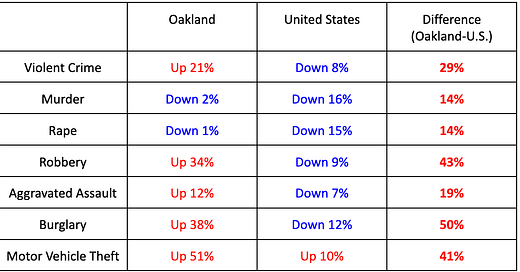The reckoning with police violence in the United States over the past decade has led to policy changes that have reduced police killings, but the consequences of those changes include reduced police activity and far more murders.
While the number of law enforcement officers has increased across the country, Oakland is in the midst of an effort to reduce our police resources by 50%, even though Oakland already employs far fewer officers per resident than the national average.
Data collected so far from 2023 indicates several categories of crime fell across the United States, in contrast to the large increases Oakland experienced.
In the 2010s, a series of high profile police killings helped many Americans better understand how police departments could violate citizens’ civil rights and evade accountability for wrongdoing. Among a variety of responses, Black Lives Matter (BLM) protests proliferated across the country. A paper published recently in the Journal for Urban Economics found that areas with BLM protests achieved the goal of fewer incidents of police violence through reduced police interactions with the public and increased adoption of body cameras (emphasis mine):
The combined effect of police pullback and the widespread adoption of body cameras led to a 10% to 15% reduction in lethal force between the end of 2014 and 2019, preventing approximately 200 police killings.
However, the Journal for Urban Economics paper also reports on some of the consequences associated with de-policing during that same time period (emphasis mine):
Over the five years after local BLM protests, property crime arrests decreased by approximately 12%, while reported murders increased by roughly 11.5%, which is over 3000 additional homicides. Moreover, the property crime clearance rate experienced a sharp decline of around 8%. These statistics are not only alarming but also offer compelling evidence of a substantial decrease in police activity.
One of the challenges liberal areas have faced in weighing policing policies is that large misconceptions about the frequency of police killings exist, particularly regarding race. A 2021 survey found that 22% of respondents who described themselves as “very liberal” thought about 10,000 or more unarmed black men were killed by police in 2019. 31% thought it was closer to 1000, and an additional 31% believed the number to be around 100. Among self-described “liberals,” the results were 12%, 27%, and 39% respectively. The Washington Post database reveals the actual number was 12.
Politically liberal Oakland implemented policing policy changes over this era as well. A “no stop” policy began in 2017 that decreased the amount of non-dispatch stops police make by 80%. After the killing of George Floyd, the city council created the Reimagining Public Safety Task Force (RPSTF), with the stated goal of diverting 50% of Oakland Police resources to alternative programs. The police budget was cut by $14.3 million in 2020, $17 million in 2021, and 120 additional officers positions were cut in the most recent FY 2023-2025 budget. Even though rising crime led to some of the funding being subsequently restored, the trend towards fewer police has been clear:
Source: City of Oakland Quarterly Police Staffing Report, May 2023
In Oakland, these cuts happened in the context of a police department that would need 1033 officers just to reach the national average of 2.4 per 1000 residents. However, it is possible that the number of officers may soon be reduced even further. In late 2023, Oakland commissioned a study to evaluate how many police are needed in the city. The inspector general decided that none of the City's 18 certified firms were capable of conducting the study and, instead, chose PFM Financial as an alternative. In an attached memo, Council President Nikki Bas included these instructions for PFM:
In order to continue expanding Oakland’s holistic community safety system, critical outcomes of this study must include:
1. Further calls for service analysis and recommendations for transferring or deprioritizing certain low level calls
2. Recommendations for further civilianization of sworn positions
While the report will not be completed until July 2024, it is worth noting that San Francisco commissioned a similar study in 2021. It recommended the city add 352 sworn officers to bring its total up to 2182, which is 2.7 per 1000 residents. By contrast, Oakland’s latest budget allows for 710 officers, or 1.6 per 1000 residents.
Instead of budgeting for police, the “holistic community safety system” Bas advocates for includes many programs that lack evidence of efficacy. For instance, last week Oakland Report ran an original analysis on the Mobile Assistance Community Responders of Oakland (MACRO) Program, which was established by the City Council in 2021 as an alternative to policing. In October 2023, the program completed its pilot phase and failed to demonstrate that it met any of its stated goals. In fact, it did not even collect the data necessary to evaluate most of them. Nevertheless, the council recently approved increasing funding from $3.1 million in 2023 to more than $9 million next year.
While Oakland prioritizes well-meaning, but unproven, programs over a fully staffed police force, the number of law enforcement officers increased in the U.S. more than 7 percent from 2021 to 2022. This increase appears to be having the desired effect. With the caveat that not all of the 2023 data is yet reported, criminologist Jeff Asher reports that the data we have, “paint(s) the picture of a large, potentially historic, decrease in crime occurring nationwide this year.” Through the first three quarters of 2023, violent crime fell 8%, leading The Atlantic to call 2023 the time of a “Peace Wave.”
Oakland saw its violent crime rise 21% over the same time period. Robberies, aggravated assaults, and burglaries are all similarly declining in the U.S. but rising in Oakland. Even Oakland’s 2% decline in murder seems hard to celebrate when compared to the 16% decrease elsewhere. Obviously, correlation is not causation, but the disparities in public safety outcomes are consistent with both the conventional wisdom and a multitude of studies showing that adequately resourced police will improve public safety.
Crime in Oakland Compared to the United States, January-September 2023
Sources: Oakland Police Department, Jeff Asher
This also contradicts the assertion made by Mayor Thao in August when she said, “I feel there that is an uptick in crime, and I know that that is happening. But that is not unique to Oakland.” While, technically, a spike in crime may not be completely unique to Oakland, the evidence we do have suggests that operating a city with far too few police officers is not working particularly well.
At times, it appears that even the strongest advocates for fewer police seem to believe that an increased police presence deters crime as well. After Colonial Donuts was robbed for a second time in a week in late December, Bas, co-author of the 50% reduction resolution, wrote this in an email to her constituents:
On Thursday, the Mayor’s Office convened a meeting of businesses with OPD and my office, where we identified concrete steps to improve safety in the neighborhood and for Colonial Donuts. This includes increased OPD visibility during peak times that crime occurs (you may have seen the patrol car outside Colonial Donuts last evening), foot patrol, and environmental design improvements like a walk up window for late night service.
After a violent 2023, let’s hope that Oakland’s leadership works to “improve safety” for all of its people, visitors, and businesses in 2024.








The data presented contrasting what sf residents vs Oakland residents get in terms of public safety is worthy of a systemic racism lawsuit. It is so clear that the current approach is putting lives of ordinary citizens and the most vulnerable at risk to test out new policy approaches. Perhaps each citizen can be monetarily compensated for the additional risk of living in a dysfunctional city.
lots of good points here - the disparity between what Oakland crime rates this year and the rest of the US is really unfortunate.
Sometimes I see counter arguments that make the point that you can't compare Oakland to the US overall and instead, you need to look at other similar sized cities - which is a fair point.
However, Oakland still performs poorly relative to other US cities, other US cities with similar population sizes, etc. On an apples to apples basis, the conclusion is the same.